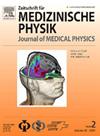Determination of the intraocular irradiance and potential retinal hazards at various positions in the eye during transscleral equatorial illumination for different applied pressures
IF 4.2
4区 医学
Q2 RADIOLOGY, NUCLEAR MEDICINE & MEDICAL IMAGING
引用次数: 0
Abstract
Purpose
With diaphanoscopic illumination of the eye, the intensity of light entering its interior depends on the transmission properties of the eyewall. Light that passes through the eyewall can cause damage to the retina. Therefore, in this study, the intraocular irradiances are determined at different positions on the retina, directly behind the illuminated eyewall, the opposite eyewall and near the macula of ex-vivo porcine eyes. These irradiances are examined for their dependence on the pressure applied on the eyewall with the illuminating fiber and for the influence of the pigmentation of the eye.
Methods
In total 221 ex-vivo porcine eyes were investigated. For transscleral illumination an illumination fiber with a diffusing adapter cap is pressed against the equatorial eyewall. The illumination fiber is pressed onto the eye and the pressure is measured in the anterior chamber. Three different pressures are applied, 23, 78 and 132 mmHg. A detection fiber with diffusing fiber tip is inserted into the eye at the desired position. The eyes were divided in groups with high and less pigmentation to investigate the influence of the pigmentation on the intraocular irradiance.
Results
The intraocular irradiances Eintra increases for various increasing applied pressures with the illumination fiber on the eyewall and for various positions inside the eye. With this the irradiances weighted with the photochemical and thermal hazard weighting function, EA-R and EVIR-R, also increases. Differences in Eintra, EA-R and EVIR-R could be found for different pigmented eyes as these values are higher for less pigmented eyes than for strong pigmented ones.
Conclusion
The hazard to the retina during diaphanoscopic illumination of the eye depends on how strong the surgeon presses the illumination fiber on the eyewall. Depending on the applied pressure and the measuring position in the eye, the specified limit for the photochemical hazard to the retina is partly exceeded. The pigmentation of the eye also plays a role. The irradiance in less pigmented eyes appears to be higher than in strongly pigmented eyes. Because of this, the surgeon should be able to adjust the intensity of the light source to the color of the patient’s eye.
在不同的加压条件下,测定经巩膜赤道照明时眼球内不同位置的辐照度和潜在的视网膜危害。
目的:在对眼睛进行透射照明时,进入眼睛内部的光线强度取决于眼球壁的透射特性。穿过眼球壁的光线会对视网膜造成损伤。因此,本研究在视网膜的不同位置测定了眼内辐照度,这些位置分别位于被照射眼球的正后方、对侧眼球和活体猪眼的黄斑附近。这些辐照度与照明光纤对眼球施加的压力有关,也受眼球色素的影响:方法:总共研究了 221 只活体猪眼睛。经巩膜照明时,将带有扩散适配帽的照明光纤压在赤道眼球壁上。将照明光纤压在眼球上,测量前房的压力。采用三种不同的压力,分别为 23、78 和 132 毫米汞柱。在所需位置将带有扩散光纤尖端的检测光纤插入眼球。将眼球分为色素沉着程度高和色素沉着程度低两组,以研究色素沉着对眼内辐照度的影响:结果:随着眼球壁上的照明纤维和眼球内的不同位置,眼内辐照度 Eintra 随施加的压力不同而增加。与此同时,使用光化学和热危害加权函数加权的辐照度 EA-R 和 EVIR-R 也会增加。不同色素眼的 Eintra、EA-R 和 EVIR-R 值存在差异,因为色素较少的眼比色素较多的眼的 Eintra、EA-R 和 EVIR-R 值要高:结论:眼球透视照明对视网膜的危害取决于外科医生将照明纤维压在眼球壁上的力度。根据所施加的压力和在眼球中的测量位置,视网膜所受的光化学危害会部分超出规定限值。眼睛的色素沉着也有影响。色素较少的眼睛的辐照度似乎高于色素较多的眼睛。因此,外科医生应该能够根据患者眼睛的颜色调整光源的强度。
本文章由计算机程序翻译,如有差异,请以英文原文为准。
求助全文
约1分钟内获得全文
求助全文
来源期刊
CiteScore
3.70
自引率
10.00%
发文量
69
审稿时长
65 days
期刊介绍:
Zeitschrift fur Medizinische Physik (Journal of Medical Physics) is an official organ of the German and Austrian Society of Medical Physic and the Swiss Society of Radiobiology and Medical Physics.The Journal is a platform for basic research and practical applications of physical procedures in medical diagnostics and therapy. The articles are reviewed following international standards of peer reviewing.
Focuses of the articles are:
-Biophysical methods in radiation therapy and nuclear medicine
-Dosimetry and radiation protection
-Radiological diagnostics and quality assurance
-Modern imaging techniques, such as computed tomography, magnetic resonance imaging, positron emission tomography
-Ultrasonography diagnostics, application of laser and UV rays
-Electronic processing of biosignals
-Artificial intelligence and machine learning in medical physics
In the Journal, the latest scientific insights find their expression in the form of original articles, reviews, technical communications, and information for the clinical practice.

 求助内容:
求助内容: 应助结果提醒方式:
应助结果提醒方式:


